Gecko
One day I got a phone call from a leading windsurfing executive and he asked me to put the Gecko on my sight because his son was impressed by this maneuver when he say Bernd Roediger (a fellow Starboard team rider) perform this manuever at the 2007 Gorge Freestyle Frenzy7. This move was invented by a young Kiri Thode in Bonaire. Sometimes inappropriately called a Flatwater or non-planing Flaka, this move is more like an Upwind 360 except you are not planing and you bury the nose in the water. The key points are learning how to put the board on edge by leading with your heals and leaning your body forward toward the nose of the board. Very light winds and a modern freestyle board (Short by Floaty) is the ideal setup even though I am using an 80 liter board in this demonstration and I weigh 185 lbs (84 Kilos).
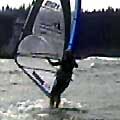

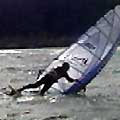
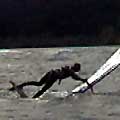
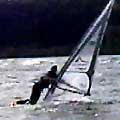

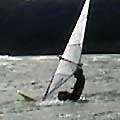
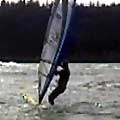
Rider: Royn Bartholdi
Steps
 1)
Head slightly up wind and wedge your feet in the footstraps. Be sure to get unhooked from your harness lines.
1)
Head slightly up wind and wedge your feet in the footstraps. Be sure to get unhooked from your harness lines.  2)
Begin by leaning slightly forward and pull the booms down into the board while rolling onto your heals to get the rail (edge) of the board to sink. &bbsp;You are basically trying to get the board on it's side and your weight above the center of the board.
2)
Begin by leaning slightly forward and pull the booms down into the board while rolling onto your heals to get the rail (edge) of the board to sink. &bbsp;You are basically trying to get the board on it's side and your weight above the center of the board.  3)
The nose will begin to dive so pull down on the boom and get your body weight forward and toward your rig. Remember to let the back leg bend to get the tail of the board out of the water and to slice the sail into the wind by not pushing out with the back hand.
3)
The nose will begin to dive so pull down on the boom and get your body weight forward and toward your rig. Remember to let the back leg bend to get the tail of the board out of the water and to slice the sail into the wind by not pushing out with the back hand.  4)
Backwind the sail and use the pressure to balance your weight over the centerline of the submerged board. Holding this position is possible because a great deal of your weight is held by the buouncy of the board and the sail pressure acts as a balancing mechanism as well as bearing some of your weight.
4)
Backwind the sail and use the pressure to balance your weight over the centerline of the submerged board. Holding this position is possible because a great deal of your weight is held by the buouncy of the board and the sail pressure acts as a balancing mechanism as well as bearing some of your weight.  5)
Now begin to release the boom pressure with your front hand and bring the mast hand vertical while you sheet out with the backhand. The rest of the moves kind of takes care of itself if you know an upwind 360.
5)
Now begin to release the boom pressure with your front hand and bring the mast hand vertical while you sheet out with the backhand. The rest of the moves kind of takes care of itself if you know an upwind 360.  6)
Push the clew threw the wind and lean back over the tail of the board... just like the ending of a Flip 360 or Upwind 360.
6)
Push the clew threw the wind and lean back over the tail of the board... just like the ending of a Flip 360 or Upwind 360.  7)
Once the board is around your weight will unfortunately be back over the tail so lean the rig forward and bend your knees to get more weight toward the centerline of the baord.
7)
Once the board is around your weight will unfortunately be back over the tail so lean the rig forward and bend your knees to get more weight toward the centerline of the baord.  8)
Standup, powerup the sail, trim, and sail away.
8)
Standup, powerup the sail, trim, and sail away. Helpful Skills
Upwind 360 as well as a Flip 360.
Tips
If you can not get the board to submarine into the water then point the nose across the wind and really roll the rail into the water by focusing on pressuring your heels and raising your toes. The idea is to knife the board into the water by reducing the surface area of the baord on the water.
All Contents Copyright © 2008-2025 Royn Bartholdi. All Rights Reserved